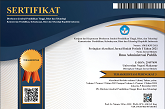Planning And Solution of Urban Infrastructure Problems Through the Integration of Collaborative GIS And Public Participation GIS
(1) Universitas Muhammadiyah Malang
(2) Universitas Muhammadiyah Malang
(3) Universitas Muhammadiyah Malang
(4) Universitas Muhammadiyah Malang
(*) Corresponding Author
DOI: https://doi.org/10.26858/jiap.v11i2.22406
Abstract
Full Text:
PDFReferences
Aggarwal, R. M., & Haglund, L. D. (2019). Advancing water sustainability in megacities: Comparative study of São Paulo and Delhi using a social-ecological system framework. Sustainability (Switzerland), 11(19). https://doi.org/10.3390/su11195314
Arif, M., & Gupta, K. (2020). Spatial development planning in peri-urban space of Burdwan City, West Bengal, India: statutory infrastructure as mediating factors. SN Applied Sciences, 2(11). https://doi.org/10.1007/s42452-020-03587-0
Average, C. (2019). Low income housing problems and low-income housing solutions: opportunities and challenges in Bulawayo. Journal of Housing and the Built Environment, 34(3), 927–938. https://doi.org/10.1007/s10901-019-09676-w
Buchori, I., Pramitasari, A., Pangi, P., Sugiri, A., Maryono, M., Basuki, Y., & Sejati, A. W. (2021). Factors distinguishing the decision to migrate from the flooded and inundated community of Sayung, Demak: A suburban area of Semarang City, Indonesia. International Journal of Disaster Risk Reduction, 52. https://doi.org/10.1016/j.ijdrr.2020.101946
Choi, M. J., & Enkhbat, U. (2020). Distributional effects of Ger area redevelopment in Ulaanbaatar, Mongolia. International Journal of Urban Sciences, 24(1), 50–68. https://doi.org/10.1080/12265934.2019.1571433
Diep, L., Dodman, D., & Parikh, P. (2019). Green Infrastructure in informal settlements through a multiple-level perspective. Water Alternatives, 12(2), 554–570. https://www.scopus.com/inward/record.uri?eid=2-s2.0-85069527999&partnerID=40&md5=91777547ceac1be5ff07ea5c52dbcf2c
El-Shorbagy, A.-M. (2020). Unplanned settlements in Saudi Arabia. The case of Al-Sabeel district, Jeddah. Journal of Settlements and Spatial Planning, 11(2), 81–94. https://doi.org/10.24193/JSSP.2020.2.03
Enríquez-de-Salamanca, Á. (2019). Vulnerability reduction and adaptation to climate change through watershed management in St. Vincent and the Grenadines. GeoJournal, 84(4), 1107–1119. https://doi.org/10.1007/s10708-018-9914-z
Hlavácek, P., Kopácek, M., & Horácková, L. (2019). Impact of suburbanisation on sustainable development of settlements in suburban spaces: Smart and new solutions. Sustainability (Switzerland), 11(24). https://doi.org/10.3390/su11247182
Hong, I.-K., Yun, H.-K., Jung, Y.-B., & Lee, S.-M. (2020). Influence of community vegetable gardens on the settlement in residential district and community spirit of local residents from perspective of urban regeneration. Journal of People, Plants, and Environment, 23(2), 139–148. https://doi.org/10.11628/ksppe.2020.23.2.139
Huang, R., Nie, Y., Duo, L., Zhang, X., Wu, Z., & Xiong, J. (2021). Construction land suitability assessment in rapid urbanizing cities for promoting the implementation of United Nations sustainable development goals: a case study of Nanchang, China. Environmental Science and Pollution Research. https://doi.org/10.1007/s11356-020-12336-0
Latham, A., & Nattrass, M. (2019). Autonomous vehicles, car-dominated environments, and cycling: Using an ethnography of infrastructure to reflect on the prospects of a new transportation technology. Journal of Transport Geography, 81. https://doi.org/10.1016/j.jtrangeo.2019.102539
Malik, S., Roosli, R., & Tariq, F. (2020). Investigation of informal housing challenges and issues: experiences from slum and squatter of Lahore. Journal of Housing and the Built Environment, 35(1), 143–170. https://doi.org/10.1007/s10901-019-09669-9
Mohamed, M. Z., & Yacout, D. M. M. (2019). Assessing the impact of urban encroachment on agricultural land in kafr El-sheikh governorate using GIS and remotely sensed data. Current Applied Science and Technology, 19(1), 57–65. https://doi.org/10.14456/cast.2019.5
Petter, A.-M., Labbé, D., Lizarralde, G., & Goulet, J. (2020). City profile: Canaan, Haiti - A new post disaster city. Cities, 104. https://doi.org/10.1016/j.cities.2020.102805
Prastica, R. M. S., Apriatresnayanto, R., & Marthanty, D. R. (2019). Structural and green infrastructure mitigation alternatives prevent Ciliwung River from water-related landslide. International Journal on Advanced Science, Engineering and Information Technology, 9(6), 1825–1832. https://doi.org/10.18517/ijaseit.9.6.8413
Radjabov, A., Berdishev, A. S., & Mussabekov, A. T. (2019). Autonomous Complex for Water Disinfection in Rural Areas of Uzbekistan. Applied Solar Energy (English Translation of Geliotekhnika), 55(2), 113–118. https://doi.org/10.3103/S0003701X19020087
Scheffer, A. P., Pagnussat Cechetti, V., Lauermann, L. P., Riasyk Porto, E., & Dalla Rosa, F. (2019). Study to promote the sustainable mobility in university. International Journal of Sustainability in Higher Education, 20(5), 871–886. https://doi.org/10.1108/IJSHE-01-2019-0031
Silveti, D., & Andersson, K. (2019). Challenges of governing off-grid “Productive” sanitation in peri-urban areas: Comparison of case studies in Bolivia and South Africa. Sustainability (Switzerland), 11(12). https://doi.org/10.3390/SU11123468
Wubie, A. M., de Vries, W. T., & Alemie, B. K. (2021). Synthesizing the dilemmas and prospects for a peri-urban land use management framework: Evidence from Ethiopia. Land Use Policy, 100. https://doi.org/10.1016/j.landusepol.2020.105122
Zhang, D., Xu, J., Zhang, Y., Wang, J., He, S., & Zhou, X. (2020). Study on sustainable urbanization literature based on Web of Science, scopus, and China national knowledge infrastructure: A scientometric analysis in CiteSpace. Journal of Cleaner Production, 264. https://doi.org/10.1016/j.jclepro.2020.121537
Article Metrics
Abstract view : 250 times | PDF view : 63 timesRefbacks
- There are currently no refbacks.
Copyright (c) 2021 Mohamad Syahrul Gunawan

This work is licensed under a Creative Commons Attribution 4.0 International License.
Diterbitkan oleh:
Program Studi Ilmu Administrasi Publik
Program Pascasarjana Universitas Negeri Makassar
JIAP Index By:

This work is licensed under a Creative Commons Attribution 4.0 International License.









